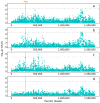Genome-wide association study of 107 phenotypes in Arabidopsis thaliana inbred lines
- PMID: 20336072
- PMCID: PMC3023908
- DOI: 10.1038/nature08800
Genome-wide association study of 107 phenotypes in Arabidopsis thaliana inbred lines
Abstract
Although pioneered by human geneticists as a potential solution to the challenging problem of finding the genetic basis of common human diseases, genome-wide association (GWA) studies have, owing to advances in genotyping and sequencing technology, become an obvious general approach for studying the genetics of natural variation and traits of agricultural importance. They are particularly useful when inbred lines are available, because once these lines have been genotyped they can be phenotyped multiple times, making it possible (as well as extremely cost effective) to study many different traits in many different environments, while replicating the phenotypic measurements to reduce environmental noise. Here we demonstrate the power of this approach by carrying out a GWA study of 107 phenotypes in Arabidopsis thaliana, a widely distributed, predominantly self-fertilizing model plant known to harbour considerable genetic variation for many adaptively important traits. Our results are dramatically different from those of human GWA studies, in that we identify many common alleles of major effect, but they are also, in many cases, harder to interpret because confounding by complex genetics and population structure make it difficult to distinguish true associations from false. However, a-priori candidates are significantly over-represented among these associations as well, making many of them excellent candidates for follow-up experiments. Our study demonstrates the feasibility of GWA studies in A. thaliana and suggests that the approach will be appropriate for many other organisms.
Figures






References
Publication types
MeSH terms
Substances
Grants and funding
- GM073822/GM/NIGMS NIH HHS/United States
- P42 ES007373/ES/NIEHS NIH HHS/United States
- R01 GM078536/GM/NIGMS NIH HHS/United States
- P42ES007373/ES/NIEHS NIH HHS/United States
- R01 GM062932/GM/NIGMS NIH HHS/United States
- R01 GM057994/GM/NIGMS NIH HHS/United States
- HHMI/Howard Hughes Medical Institute/United States
- R01 GM073822/GM/NIGMS NIH HHS/United States
- GM057994/GM/NIGMS NIH HHS/United States
- BBS/E/J/000CA355/BB_/Biotechnology and Biological Sciences Research Council/United Kingdom
- GM62932/GM/NIGMS NIH HHS/United States
- GM078536/GM/NIGMS NIH HHS/United States
LinkOut - more resources
Full Text Sources
Other Literature Sources
Molecular Biology Databases

